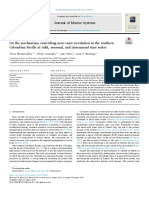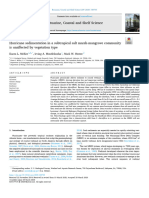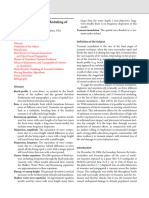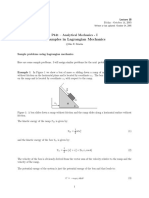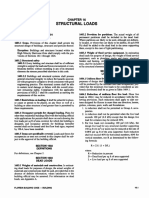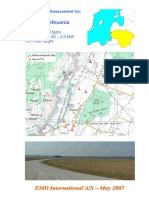2008 Physicstoday RW
2008 Physicstoday RW
Uploaded by
Anonymous rn2qoBPjKyCopyright:
Available Formats
2008 Physicstoday RW
2008 Physicstoday RW
Uploaded by
Anonymous rn2qoBPjKyOriginal Title
Copyright
Available Formats
Share this document
Did you find this document useful?
Is this content inappropriate?
Copyright:
Available Formats
2008 Physicstoday RW
2008 Physicstoday RW
Uploaded by
Anonymous rn2qoBPjKyCopyright:
Available Formats
Modeling the physics
of storm surges
Donald T. Resio and Joannes J. Westerink
Despite the potentially catastrophic consequences of storm surges, the
physics of surge generation and propagation has historically been poorly
understood, and many misconceptions about surges still exist.
Don Resio is a senior scientist at the US Army Engineer Research and Development Center in Vicksburg, Mississippi. Joannes
Westerink is a professor in the department of civil engineering and geological sciences and concurrent professor of mathematics at
the University of Notre Dame in Notre Dame, Indiana.
Eight of the ten largest cities in the world are lo- gis often transcend the limits of local calibrations. Moreover,
cated on the coast and 44% of the worlds population lives reliance on such calibrations precludes using models to an-
within 150 km of the ocean.1 Unfortunately, coastal regions swer important questions related to variations in the system
are often low-lying and thus susceptible to an increase in sea- itself or meteorological forcing mechanisms. An important
surface elevation. example concerns the role of wetlands in coastal protection,
A storm surge is a potentially devastating rise in the sea which is difficult to assess if the predictive model is specifi-
surface caused by extratropical cyclones or by tropical cy- cally tuned to work for the existing wetland configuration
clones such as hurricanes and typhoons. Surges can lead to and for a select set of storms. Empirical rules of thumb based
large loss of human life, destruction of homes and civil in-
frastructure, and disruption of trade, fisheries, and industry.
Since tropical cyclones have lower interior pressures and Vulnerable New Orleans
higher wind speeds than extratropical cyclones, they typi-
cally produce significantly higher surges than extratropical It has long been recognized that hurricanes represent a par-
cyclones do. Their effects extend across the western Atlantic ticularly grave threat to New Orleans, Louisiana. In a 1929
Ocean, the Gulf of Mexico, and the western Pacific and In- article for the Engineering News-Record, Arthur M. Shaw
dian oceans. Hurricane Katrina, the 2005 storm that struck noted that the recorded hurricanes of the early 20th century
southern Louisiana and Mississippi in the US, and Cyclone had approached New Orleans along southwesterly tracks.8
Nargis, which made landfall in Myanmar in 2008, provide In addition, he recognized the considerable vulnerability due
ample evidence of the ruinous effects of storm surges. to hurricane protection levees that were too low or poorly
As in most scientific fields, the early foundation of surge maintained and due to drainage canals that, as an editorial
prediction relied heavily on observational data and on rela-
sidebar to the article pointed out, like sword thrusts extend
tionships that were suggested by those data. Surge events,
to the very heart of the city. The sidebar also observed that
however, are rare, and the associated historical data are lim-
New Orleans is wide open to inundation should [a] storm
ited. As described in the box at right, such limitations are one
reason planners did not effectively act on warnings that New come from another or eastern direction.
Orleans is vulnerable to hurricanes. Furthermore, the forces In retrospect, the concerns expressed in the article were
that drive surges are different from one storm to another, and insightful. By and large, however, they have not been
a storms characteristics evolve. For all those reasons, direct heeded in southern Louisiana, for several reasons. First, most
deductions about the regional and local impacts are of lim- of the emphasis on flood protection in the region has been
ited use. on the much more prevalent threat from the Mississippi River.
The advent of digital computers in the 1960s led to dis- Second, at least prior to Hurricane Katrina, the infrequency
crete computational solutions of the governing equations, a of major hurricane surges made it difficult for planners to
significant advance over earlier empirical methods. But maintain a consistent focus on coastal hazards in the region.
those early calculations were limited by the scope and scales Third, analytical results obtained in previous studies were not
of the modeled physics, the modest size of the regions over taken at face value by many planners, perhaps justifiably so.
which the computations were performed, and the lack of Many of the dire warnings of impending flooding in the New
spatial resolution of critical phenomena influencing the so- Orleans area came from models predicting that the major
lutions. As a result, they required extensive case- and region- threat was from overtopping of the Lake Pontchartrain levees
specific calibration or tuning of the boundary forcing and on the north side of the city. As it turns out, that threat was
model parameters. Indeed, those early codes were at the
highly overrated. On the other hand, the more serious
crossroads of physics simulators, which rely on fundamen-
threats to the levees in Saint Bernard and Plaquemines
tal underlying physics, and tuned interpolators, which rely
parishes and potential problems in the canals were not fully
on observational data.
Unfortunately, extreme storms such as Katrina and Nar- appreciated.
2008 American Institute of Physics, S-0031-9228-0809-010-8 September 2008 Physics Today 33
on observations alone may with steep offshore slopes.
be of dubious value. Along In the real world,
the US Gulf Coast, observa- 3 coastal-basin geometries can
tions have suggested that be very complex both across
MAXIMUM SPEED (m/s)
each 14.5 km of wetlands and along the shelf. Natural
leads to a 1-m decrease in the scales of variability range
maximum surge level.2 If 30 2 from those of broad geomor-
true, that is an extremely phic features such as river
LATITUDE
useful piece of information. deltas, barrier islands, and
The estimate could be dan- bays, down to detailed fea-
gerous, however, if it is false 1 turescoastal rivers and
and used to estimate risk re- streams, distributary chan-
ductions in coastal areas be- nels in wetlands, and cuts
hind wetlands. 29 through reefed areas, for ex-
In this article we de- 0 amplethat affect flows in
scribe some important con- 90 89 coastal areas. Manmade fea-
cepts for storm-surge predic- LONGITUDE tures include extensive lev-
tion and examine how the ees and raised highways that
modeling communitys un- Figure 1. Water speed depends on geographic features. block flows, and canals, un-
derstanding of the relevant In this simulation, maximum speeds during Hurricane derpasses, and culverts that
processes is evolving from Katrina got as high as 2.5 m/s through inlets, through allow flows to pass through
one based on empirical data constrictions, and over barrier islands and approached them. In addition, the scales
to one based on fundamental 12 m/s over broad swaths of the continental shelf. of such forcing processes as
physics. That fundamental are associated with wind and
physics includes forcing wave fields can range from
mechanisms, all of which meters in complex shallow
must be properly specified, and dissipation mechanisms that areas to hundreds of kilometers in large deep basins. Geo-
act on the flows and must be properly defined. Accurate metric complexity thus produces a richness of interacting
modeling also requires an adequate specification of the sys- scales of motion that must be resolved correctly in modeling
tem geometry to ensure appropriate hydrodynamic response applications.
to the forcing, including computational resolution of all en- Some idea of the types and scales of features in a hurri-
ergetic scales of motion.3 We also explore the interrelation- cane surge can be seen in figures 1 and 2. Figure 1 shows the
ship between the physics and computational models and simulated maximum water velocities during Hurricane
offer our perspective on future directions in forecasting and Katrina. The velocity response functions and the high spatial
risk assessment. gradients of the system, forcing functions, and surface eleva-
tion must all be sufficiently locally resolved if the physics of
Geometry has a profound effect the water movement is to be properly simulated.
More than two centuries ago, in 1775, Pierre Simon Laplace Figure 2 shows three snapshots from a model simulation
published the basic form of the equations that largely de- of surge height and wind velocity during Katrina. Together
scribe tides and storm-surge propagation in the coastal ocean they cover a five-hour period. Note, though, that hurricane
and adjacent floodplain. The physics behind the equations in- wind speeds are not uniquely defined. Wind speeds obtained
volves the conservation of both water volume and momen- from aircraft excursions into hurricanes are often reported in
tum. The momentum balance involves various processes in- newscasts as a hurricanes maximum wind speed. Those
cluding acceleration, wind stress, momentum transfer from measurements represent the fastest one-minute-duration
wind-generated surface waves, atmospheric pressure, wind speeds encountered by the aircraft at its flight level.
EarthMoon gravitational effects, frictional drag at the sea Ocean-response models use winds averaged over 1030 min-
bottom, and lateral mixing. The online version of this article utes, at a reference height of 10 m. Theoretical and observa-
includes the shallow-water equations, a generalization of tional evidence shows that the wind speeds at the reference
Laplaces tidal equations, and gives physical interpretations level are only about 6575% of speeds at flight level. Also, for
of their individual terms. a given height, wind speeds averaged over 1030 minutes
Storm surges are strongly influenced by the geometry of will typically be about 80% of the maximum 1-minute wind
the basin and continental shelf leading up to the coastal speeds. All told, the hurricane speeds used in ocean-response
floodplain. As a first approximation, however, one can em- modeling are typically only in the range of 3060 m/s.
ploy a simple, linear, steady-state equation to understand the
influence of water depth and shelf width on wind-driven Dont neglect wave momentum
surges: Coastal surges are driven primarily by momentum transmit-
ted to the water column in situ by winds and by momentum
(s/gh)W. (1) that enters the water column after being transported over a
Here is the surge height at the coast, s is the wind stress distance by waves. Early surge models neglected the wave
at the airsea interface, and g is the gravitational accelera- input and attempted to use local model calibration to com-
tion. The two cross-shelf geometric factors are h, the depth pensate for that omission. The wind contribution to rate of
of the water, and W, the shelf width. Admittedly, the physics gain of momentum per unit surface area in a water column
becomes much more complex when one considers that can be written as
depths are variable and that the surge itself dramatically af-
s = cd a w2, (2)
fects depth. Still, it is easy to see that shelves with a large
shallow-water area will produce larger surges than those where cd is the coefficient of drag, a is the air density, and w
34 September 2008 Physics Today www.physicstoday.org
a 45 m/s b 45 m/s
8 8
7 7
30 6 30 6
HEIGHT (m)
HEIGHT (m)
5 5
LATITUDE
LATITUDE
4 4
3 3
2 2
1 1
29 0 29 0
1 1
90 89 90 89
LONGITUDE LONGITUDE
c Figure 2. Propagating surges and changing wind-velocity
45 m/s
fields are evident in these three snapshots of Hurricane
8 Katrina simulations. In all three panels, dry areas are gray,
7 and the color bar indicates water-surface elevation. Velocity
magnitude as defined in the text scales with the size of the
30 6
velocity arrow, with the size corresponding to 45 m/s given
HEIGHT (m)
5 in the upper right of each panel. (a) Katrina makes its first
LATITUDE
4 landfall near Buras, Louisiana, at 6:00am local time,
3 29 August 2005. Here the surge, which has attained heights
2 in excess of 6 m, is being driven against the levee system
that runs along the Mississippi River in Plaquemines Parish.
1
Within several hours the surge will spill into the Mississippi
29 0 River and propagate upriver past New Orleans with an am-
1 plitude of 4.7 m. (b) By 9:00am local time, Katrina has
90 89 moved across the river delta and over Lake Borgne. Part of
LONGITUDE
the surge that was pushed against the levees has reflected
into Breton Sound and is combining with the wind-driven
surge to form a wave propagating across an area of rela-
tively shallow water. This panel makes clear the effects of the
is the wind speed. In early storm-surge models, the coeffi- coastal configuration on shaping the surge. Note the large
cient of drag was taken to be as large as necessary for the amplitudes along the northern portion of the parish where
model to fit local calibration data. But work by Mark Powell the winds are directed toward the Saint Bernard levees and
and colleagues4 and extensive follow-up studies have shown the lower surges where the winds are blowing away from the
that cd is no greater than about 0.0025 in the region of the levees south of the parish. (c) Five hours after the first land-
strongest surge generation in hurricanesa factor one-half fall, the surge along the Mississippi coast is at a maximum.
to one-third as large as the values previously used. The combination of a large expanse of very shallow water
Much of the problem can be remedied by including mo- and the blocking of the flow toward the west has produced
mentum transfers from waves in addition to the direct trans- extreme surge heights of more than 8 m.
fer from winds. The flux of that momentum transfer, termed
a radiation stress, arises from a wave-momentum flux diver-
gence that is primarily related to wave breaking. Older mod- contribution. Such steep slopes might be found, for example,
els that neglected wave-momentum sources implicitly re- near reefed islands or levees. In any case, figure 3 makes it
placed cd in equation 2 with cd = cd(1 + R), with R the ratio of clear that both the direct wind stress and the wave radiation
the transfer rate of wave momentum to the transfer rate of stress need to be separately included in surge models.
wind momentum. If R were a universal constant, a model that Hurricane wind fields can be complex. A range of phe-
combined the wind and wave inputs in a single term would nomena interact to form complicated wind features such as
be justifiable. However, the momentum transfer rate from spiral bands and embedded high-velocity regions. Land
wave breaking is highly dependent on the slope and depth proximity and the cycles in which a hurricanes eye wall
of the sea bottom. Its variation, both across a region of inter- breaks down and is reestablished (eye-wall replacement cy-
est and from site to site, is therefore considerable and rela- cles) can also markedly affect winds in a storm. Despite that
tively independent of the wind contribution. complexity, a hurricane is in essence a heat engine (see the
Not surprisingly, the different theoretical approaches, Quick Study by Kerry Emanuel in PHYSICS TODAY, August
simulated wave-momentum transfer rates, and wave- 2006, page 74), and much of the structure of its wind field has
breaking forms used in various models lead to different cal- been found to be well represented by a relatively small set of
culated values for R. Figure 3 shows the envelope of the re- parameters. Primary among those are storm intensity, size,
sulting wave contribution to storm surge as a function of sea- forward speed, and a peakedness function. Coastal-surge
bottom slope. For steep slopes, waves make the dominant models driven with best-fit parametric wind fields dont have
www.physicstoday.org September 2008 Physics Today 35
grate the joint probability beyond the appropriate contour
1.0 line in figure 4 to determine the probability that a storm will
WAVE CONTRIBUTION TO STORM SURGE
generate a surge of at least a given height. Given the observed
frequency of hurricanes along the Gulf Coast, a hurricane
that generated Katrina-like surges would come along once in
0.8
about 400 years.
Wetlands dont always mitigate surges
0.6 Modelers and community planners alike want to know the
degree to which marshes and coastal forests slow inland
surge penetration. A commonly stated rule of thumb says
0.4 that a storm surge is attenuated at a rate of 1 m for every
14.5 km of marsh as the surge propagates inland from the
shore. That estimate is based on a US Army report that ex-
0.2 amined inland penetration for seven storms occurring be-
tween 1909 and 1957 throughout southern Louisiana.2 How-
ever, the data display considerable scatter and suggest that
the attenuation rate for those storms ranges from 1 m per
0
0 2000 4000 6000 8000 10 000 20 km to 1 m per 7 km.
1/slope The frictional effects responsible for attenuation influ-
ence both the vertical and lateral structures of currents. In
Figure 3. Wind and waves transfer momentum that con- depth-averaged two-dimensional models, bottom friction is
tributes to a surge. The wave contribution is highly depen- typically represented by a quadratic surface-drag law simi-
dent on the slope of the sea floor. The two curves bounding lar to that for surface wind stress. Lateral frictional effects are
the yellow slice give a range for the fractional contribution represented with a relationship similar to Newtonian viscous
of waves to the total surge, as calculated in various models. dissipation and require high resolution when spatial gradi-
On steep slopes, waves make the dominant contribution. ents in currents are large. After wind and wave forcing di-
But even on shallow slopes, the wave contribution could minishes substantially, forces generated by friction and the
still be significant; waves added about 24 feet gradient of the water surface become dominant in most
(0.61.2 m) to the surges during Hurricane Katrina. coastal areas. The decoupling of the wind and wave forcings
is fortunate because during the slow, frictionally dominated
recession process, the modeling of friction can be validated
independently of the representation of those forcing fields.
any greater systematic error than models employing wind The assumption of a constant attenuation rate, as in the
fields that are not parametrically constrained. But because US Army report, implies a simple balance between the gra-
they dont account for all the detail of a storms structure, the dient of the water surface and bottom friction. The large at-
parametric models have 1020% higher random errors. tenuation range actually observed suggests that the situation
is more complex. In fact, attenuation depends on many de-
Larger storms bring higher surges tails, including momentum balance; the storms track, for-
A few months after Hurricane Katrina, the Sun Herald of ward speed, duration, size, and associated waves; the
Biloxi, Mississippi, wrote that Camille killed more people in regional bathymetry and topography, including shelf width
2005 than it did in 1969.5 Many residents did not evacuate and barrier islands; the local geometry; levee and raised-
from areas that remained dry during Hurricane Camille, a feature elevations; inland bathymetry and topography,
category-5 storm on the standard Saffir-Simpson scale. They including the channels that interconnect water bodies; and
believed they were perfectly safe from Hurricane Katrina, the local surface roughness.
only a category-3 storm when it struck the Mississippi coast. Increased frictional resistance slows the rate at which
But Katrina was much larger than Camille, and tragically, water moves inland. The resulting increased seaward surge
that made it a more dangerous generator of storm surge.6 levels can cause increased water levels in portions of the sys-
Figure 4 illustrates the influence of storm size and in- tem. Increased friction also leads to a steepening of the surge
tensity on surge elevations for two slopes typical of shelf front as it propagates inland. The surge amplitude can be at-
areas in the Gulf of Mexico. It drives home the important tenuated by friction as the surge propagates inland, but the
point that coastal inundation risks cannot be well posed in degree of attenuation also depends on the structure and du-
terms of only storm frequency and intensity. In particular, the ration of the forcing winds and waves. Hurricane Rita fur-
data given in the figure suggest that along the Mississippi nishes an instructive example; the storm struck the Gulf coast
coast, a storm of Camilles size cannot produce a surge equal a month after Katrina. In western Louisiana, Rita, which was
to Katrinas unless it is far more intense in the Gulf of Mex- on a fast southeast-to-northwest track, blew water away from
ico than presently believed possible. the coast and then plunged water onto land as the eye of the
Simulations such as those presented in figure 4 can also storm passed rapidly. Figure 5 shows the maximum com-
help meteorologists estimate the probability that a hurricane puted water levels during the storm for the western part of
will produce a surge of at least a given amplitude. The prod- the state; maximum inland attenuation rates ranged from
uct of accepted individual probability distributions for storm 1 m per 11 km to 1 m per 19 km.
intensity and size yields the joint probability distribution for A very different scenario occurred in eastern Louisiana,
storms with a specified intensity and size. Neglecting effects where Rita blew nearly steady easterly to southeasterly
related to storm speed and the angle of approach to land, winds toward the protruding delta. Figure 6 shows the com-
which tend to affect surges to a lesser extent, one can inte- puted maximum water levels in the region; indeed, during
36 September 2008 Physics Today www.physicstoday.org
much of the event, the water-surface elevation was near that must eventually be carefully examined in well-resolved 3D
maximum. The maximum surge at English Turn occurred in simulations that may ultimately rely less on local calibration
an area fronted by almost 40 km of marsh and shows an in- data. The increased computational burden for 3D simulation
crease of surge across the marsh up to the point where the is not too large, perhaps a factor of two. So it is likely that a
flow was stopped by the Mississippi River levees. The dom- shift to vertically resolved simulations will occur in the near
inant momentum balance here is between wind stress and future.
water-surface gradient terms. Water levels, which increased The physics communitys understanding of the genera-
over the marsh at a rate of +1 m per 46 km, would have in- tion, propagation, and attenuation of storm surges has sig-
creased more steeply if the winds had been higher. Thus, al- nificantly evolved over the past decade. One major improve-
though friction played a role in how fast the water got to Eng- ment has been to include wave radiation stress to force
lish Turn, it ultimately did not determine surge levels there surges. Other significant advances include vastly improved
since the winds blew almost steadily for a full day. In short, resolution and the use of objective functions for specifying
significant frictional resistance may slow the progress of bottom drag. Recently the focus has shifted to accurate sys-
water getting somewhere, but if the wind blows long enough temwide descriptions and multiprocess, high-resolution sim-
and strongly enough, the water will get there. ulations that cover basin-scale regions. Such simulations are
now possible thanks to the availability of high-performance,
The third dimension and beyond large-scale parallel-computing platforms. Given accurate,
To facilitate numerical solutions, modelers assume that ver- well-resolved forcing functions to represent winds, waves,
tical motions of water within coastal areas can be neglected atmospheric pressure, tides, and riverine flows, modelers
relative to horizontal motions. In addition, they assume that could approach the capacity to simulate the fundamental
an idealized depth-averaged slab of water will act like an ac- physics.
tual water column that includes a vertical distribution of hor- Nowadays, models use historical data to determine sub-
izontal velocities. That additional simplification works well grid-scale processes, and they are beginning to achieve high
for pressure-driven flows such as tidal and riverine flows in levels of accuracy without the extensive local tuning required
shallow coastal waters; in those cases the vertical variation of in the early days. For example, in a study by the US Army
the horizontal velocities is minimal except near the very bot- Corps of Engineers that hindcasted Hurricane Katrina,7 the
tom of the water column. standard deviation for the difference between observed and
Wind and wave forcings, however, are applied at the top modeled high-water marks was 0.4 m. Still, that leaves con-
of the water column, and the combination of faster surface siderable room for improvement, particularly considering
flows and a bottom return current can affect a coastal surge. the cost of protection systems and the impact of storm surges.
Specifically, faster surface currents reduce the difference be- For example, future models will need to incorporate im-
tween wind and water speeds. As a result, the momentum proved knowledge of the coastal winds in hurricanes, specif-
transfer rate between air and sea is slightly reduced, and ically the details of the eye-wall-structure and open-water
surges are diminished. Con-
versely, bottom-layer return
currents yield a shoreward PEAK SURGE (m) PEAK SURGE (m)
bottom stress that is added to 1 2 3 4 1 2 3 4 5 6 7 8
the wind stress and thus en-
130 130
hances surge. Those opposing
effects depend strongly on 120 120
depth, local bathymetry, and
vertical mixing rates in a 110 110
INTENSITY (mbar)
INTENSITY (mbar)
water column. Parametric 100 100
studies suggest that the net re-
sult is usually an increased 90 90
surge level, in extreme cases
by 25%. 80 80
Present-day model appli- 70 70
cations on large domains typ-
ically do not consider 3D ef- 60 60
fects. The good agreement of
2D simulations with observa- 50 50
tions suggests that the net for- 40 40
ward momentum enhance- 10 20 30 40 50 60 70 10 20 30 40 50 60 70
ments are lumped in with the SIZE (km) SIZE (km)
airsea drag coefficient, which
in models is somewhat larger Figure 4. A storms size and intensity both contribute to storm surge. These contour plots
than suggested by observa- show surges from idealized simulations that assumed a constant sea-bottom slope of
tions. But lumping distinct 1/1000 (left) and 1/10 000 (right), typical values along the Louisiana and Mississippi
processes into parameters ul- coasts. Storm size is measured by the radius to the maximum winds and intensity by the
timately reduces the accuracy difference between peripheral and central pressures. Results are extrapolated linearly be-
of models. If modelers are to yond the simulation range indicated by vertical lines. The superimposed geometric figures
achieve more refined physics- give data for historic storms in the Gulf of Mexico. The two most intense storms are Hurri-
based predictions, then the net canes Camille (large black triangle) and Katrina (large red triangle). Even though Katrina
effect of momentum flux dis- was the less intense of the two, its size caused it to produce a much higher surge.
tributed in space and time
www.physicstoday.org September 2008 Physics Today 37
5 5
30 4
4
30
LATITUDE
HEIGHT (m)
3
HEIGHT (m)
LATITUDE
2 2
1 1
29
0 0
29
1 1
94 93 92 91 90 89
LONGITUDE LONGITUDE
Figure 6. For slow-moving storms with nearly steady
Figure 5. Inland marshes can attenuate storm surges, as
winds, surge levels can increase as one moves inland over
happened in western Louisiana during Hurricane Rita. In
marshland. Thats what occurred in eastern Louisiana dur-
this contour plot of simulated surge elevations, maximum
ing Hurricane Rita. In this contour plot of simulated surge
surges occur at the coast. The vertical arrows aligned
elevations, the arrow indicates the track inland from the
roughly eastwest through the maximum indicate tracks in-
edge of the Caernarvon marsh to English Turn that was
land from the coast that were used to estimate maximum
used to estimate the maximum rate of surge increase.
surge attenuations.
wind-structure changes as hurricanes approach landfall. Fur- been mainly a response to previous floods. Consider, for ex-
thermore, they will require better quantification of the ample, southern Louisiana. In response to frequent riverine
physics of airsea momentum transfer, including the effects and less frequent hurricane floods, levee systems there have
of water depth and wave conditions. Missing in todays for- been built higher and longer, often along the banks of exist-
mulations are the effects of wind, wave, and current flows ing rivers and bayous. That is not necessarily a good strategy
through partially or fully submerged vegetation and inte- for hurricane protection, particularly in the protruding Mis-
grated frictional effects of a wetlands complex subgrid-scale sissippi deltalong, continuous, high levees dam the flow,
channels and distributary systems. which results in increased surge levels. Furthermore, long
Rainfall runoff should be considered as an integral part continuous levees stop the natural sedimentation processes
of flooding computations. It has traditionally been neglected necessary to build up the delta and maintain wetlands.
in coastal hurricane flood modeling, but runoff becomes im- Simulations suggest that it is possible to design localized
portant in many contexts, including inland areas, partially ring levee systems that, in coastal areas, more effectively pro-
or fully sheltered embayments, and leveed areas. Models tect against floods and manage sediment. It is our hope that
will have to address the vigorous geomorphic changes as- todays and tomorrows models will be used for a rethinking
sociated with hurricanes, including deepening of channels; of flood protection that rejects the traditional reactionary
degradation and breaching of barrier islands, coastal dunes, short-term approach and looks far into the future.
and levees during the storm; and deposition of sediment
during the floodwater recession. All of those can affect the Both authors were supported in part by the System-Wide Water
details of a flood. Resources Program of the US Army Corps of Engineers. The chief of
Given the existing observation base, we believe that the engineers has granted permission for publication of the contents of this
new generation of surge models can provide valuable infor- article. One of us (Westerink) was also supported in part by NSF,
mation for most US coastal areas. Being more firmly based under grant OCI-0746232.
in the physics of the processes and less linked to local cali-
bration, those models should also provide useful estimates
References
of surges in a future that is likely to include sea-level rise, 1. United Nations Atlas of the Oceans, Human Settlements on the
Coast, http://www.oceansatlas.org/id/1877.
new flood-protection structures, variation in upland
2. Corps of Engineers, US Army Engineer District, New Orleans,
drainage patterns, and possible loss of wetlands. It is essen- Interim Survey Report, Morgan City, Louisiana and Vicinity, serial no.
tial, however, for surge modelers to further refine the effects 63, US Army Engineer District, New Orleans, LA (November
of the many processes that contribute to storm surge by dis- 1963).
tinctly accounting for each process and by using microscale 3. J. J. Westerink et al., Mon. Weather Rev. 136, 833 (2008).
observation to improve the parameters that estimate sub- 4. M. D. Powell, P. J. Vickery, T. A. Reinhold, Nature 422, 279 (2003).
grid-scale effects. 5. J. Norman, Sun Herald (Biloxi, MS), 12 February 2006, p. A1.
We who model surges want decision makers to have con- 6. J. L. Irish, D. T. Resio, J. J. Ratcliff, J. Phys. Oceanogr. (in press).
7. Corps of Engineers, US Army Engineer District, New Orleans,
fidence in our models and to trust them to provide vital in-
Flood Insurance Study: Southeastern Parishes, LouisianaDraft Inter-
formation. But that will only happen if our predictive tools mediate Submission 2: Offshore Water Levels and Waves (rep. prepared
realistically represent all important surge processes. Accu- for the Federal Emergency Management Agency, Region 6), US
rate simulation methods will help those in charge to avoid Army Engineer District, New Orleans, LA (January 2008).
repeating the historical pattern in which flood protection has 8. A. M. Shaw, Eng. News-Rec. 102, 698 (1929).
38 September 2008 Physics Today www.physicstoday.org
You might also like
- Literature Review of Niger Delta BasinDocument7 pagesLiterature Review of Niger Delta Basinmtxziixgf100% (1)
- British Code BS 6399 Part 2 Wind 20loadsDocument92 pagesBritish Code BS 6399 Part 2 Wind 20loadsMdShahbazAhmed92% (12)
- Kemp 01Document228 pagesKemp 01KatrinaDocsNo ratings yet
- Solutions Goldstein Chapter 9 1Document19 pagesSolutions Goldstein Chapter 9 1Anonymous rn2qoBPjKy67% (3)
- Design Calculation For Electro-Chlorination Skid-Rev - 4Document150 pagesDesign Calculation For Electro-Chlorination Skid-Rev - 4raghuvarma100% (1)
- Design, Modeling, Analysis and Calculation of Offshore Module StructureDocument208 pagesDesign, Modeling, Analysis and Calculation of Offshore Module Structureapirakq100% (3)
- Notes DRRR 6.2Document2 pagesNotes DRRR 6.2Noella may de MesaNo ratings yet
- Ajem 13 04 13Document7 pagesAjem 13 04 13JessicaNo ratings yet
- Flood Hazard Assessment and Zonation: Drs. Nanette C. KingmaDocument40 pagesFlood Hazard Assessment and Zonation: Drs. Nanette C. KingmaReta Birhanu BirhanuNo ratings yet
- Design of Buildings Against Natural Hazards: Course No: C01-013 Credit: 1 PDHDocument19 pagesDesign of Buildings Against Natural Hazards: Course No: C01-013 Credit: 1 PDHAbhishekJugbandhanNo ratings yet
- State of Knowledge On Measurement and Modeling of Coastal OverwashDocument28 pagesState of Knowledge On Measurement and Modeling of Coastal Overwashemilyac01No ratings yet
- Far-Field Tsunami Hazard in New Zealand PortsDocument26 pagesFar-Field Tsunami Hazard in New Zealand PortsMithun KanishkaNo ratings yet
- Forecasting Coastal Overtopping at Engineered and Naturally Defended CoastlineDocument17 pagesForecasting Coastal Overtopping at Engineered and Naturally Defended CoastlineDinar IstiyantoNo ratings yet
- Rudy Van Drie Full PaperDocument15 pagesRudy Van Drie Full PaperRudy Van DrieNo ratings yet
- Remote Sensing of Floods and Flood-Prone Areas: An Overview: Review ArticlesDocument9 pagesRemote Sensing of Floods and Flood-Prone Areas: An Overview: Review ArticlesSyed Muhimeen AhmedNo ratings yet
- Glof Detection and Hazard Estimation: Assignment OnDocument19 pagesGlof Detection and Hazard Estimation: Assignment OnAnsuman ChakrabortyNo ratings yet
- Storm Surge Inundation Assessment in Poblacion Lawaan, Eastern Samar Using GisDocument12 pagesStorm Surge Inundation Assessment in Poblacion Lawaan, Eastern Samar Using Gisgrimmjow sinclairNo ratings yet
- Slemmons&dePolo 1986Document19 pagesSlemmons&dePolo 1986cesar garcia jr.No ratings yet
- Rainfall Intensi Fication Amplifies Exposure of American Southwest To Conditions That Trigger Post Fire Debris OwsDocument10 pagesRainfall Intensi Fication Amplifies Exposure of American Southwest To Conditions That Trigger Post Fire Debris OwscgistNo ratings yet
- Escobar Etal 2015 MarineCurrentsGU PDFDocument12 pagesEscobar Etal 2015 MarineCurrentsGU PDFRICARDO ANDRÉS QUINTANA BARRANCONo ratings yet
- On The Water Palisade Bay: Courrents: Projects For New York's Waterfront, Opening at The MuDocument33 pagesOn The Water Palisade Bay: Courrents: Projects For New York's Waterfront, Opening at The MuLefteris SpirouNo ratings yet
- Williams-Lck-Vogel2020 Article ComparativeAssessmentOfTheGISBDocument15 pagesWilliams-Lck-Vogel2020 Article ComparativeAssessmentOfTheGISBJessicaNo ratings yet
- Silva Et Al, 2022. Onthe Mechanisms Controlling Near Coast Circulation in The Southern Colombian PacificDocument15 pagesSilva Et Al, 2022. Onthe Mechanisms Controlling Near Coast Circulation in The Southern Colombian PacificNatalia Zapata DelgadoNo ratings yet
- Lumbroso Vinet Nhess-Comparison Xynthia 1953Document13 pagesLumbroso Vinet Nhess-Comparison Xynthia 1953kaeyuserNo ratings yet
- J Flood Risk Management - 2024 - Chilton - Historical Analysis of Tropical and Non Tropical Induced Flooding Within TheDocument14 pagesJ Flood Risk Management - 2024 - Chilton - Historical Analysis of Tropical and Non Tropical Induced Flooding Within TheMirian ApazaNo ratings yet
- 2-@@@from Mehrdad-Response Based Design Conditions in The North Sea Applicaiton of A New Method-1995Document12 pages2-@@@from Mehrdad-Response Based Design Conditions in The North Sea Applicaiton of A New Method-1995Ali Ghasemi Koohi KheiliNo ratings yet
- 2013 Bookmatter CoastalHazardsDocument21 pages2013 Bookmatter CoastalHazardsAyesha AzizNo ratings yet
- Proactive Method in Managing Severe Weather ConditionsDocument11 pagesProactive Method in Managing Severe Weather ConditionsGabriel MacaulayNo ratings yet
- River Management and Floodrisk Reduction Using St-Hydrotheek (Stowa) 157583Document8 pagesRiver Management and Floodrisk Reduction Using St-Hydrotheek (Stowa) 157583ALAN VELÁSQUEZ BERMEONo ratings yet
- 2020 Large Debris Flows in ChosicaDocument13 pages2020 Large Debris Flows in ChosicaAna CruzNo ratings yet
- Active Faults in Dam Foundations: An Update: Clarence R ALLEN and Lloyd S CLUFFDocument8 pagesActive Faults in Dam Foundations: An Update: Clarence R ALLEN and Lloyd S CLUFFShahzaib AliNo ratings yet
- Ortiz Et Al 2021Document11 pagesOrtiz Et Al 2021Angie MolinaNo ratings yet
- Storm Surge ThesisDocument6 pagesStorm Surge Thesisjuliejensenrochester100% (1)
- McKee Et Al 2020. Hurricane Sedimentation in A Subtropical Salt Marsh-Mangrove Community Is Unaffected by Vegetation TypeDocument12 pagesMcKee Et Al 2020. Hurricane Sedimentation in A Subtropical Salt Marsh-Mangrove Community Is Unaffected by Vegetation Typezaragoza.angNo ratings yet
- Flood Riskassessment and Risk Reduction in Montreal: Abstract - 3. Floods - Natural Hazards?Document7 pagesFlood Riskassessment and Risk Reduction in Montreal: Abstract - 3. Floods - Natural Hazards?Deepika ManglaNo ratings yet
- A Multi Parameter Study of Groundwater-Seawater Interactions Along Partido de La Costa, Buenos Aires Province, ArgentinaDocument14 pagesA Multi Parameter Study of Groundwater-Seawater Interactions Along Partido de La Costa, Buenos Aires Province, ArgentinaMas'ud KholahNo ratings yet
- Impact of Wind-Driven Circulation On Contaminant Dispersion in A Semi-Enclosed BayDocument14 pagesImpact of Wind-Driven Circulation On Contaminant Dispersion in A Semi-Enclosed BayFloraNo ratings yet
- 1 s2.0 S0272771417302524 MainDocument14 pages1 s2.0 S0272771417302524 MainMelvin DanginNo ratings yet
- Debasmita Dutta, Roll No - 63Document15 pagesDebasmita Dutta, Roll No - 63duttasarkardebdip2003No ratings yet
- Bams BAMS D 21 0121.1Document19 pagesBams BAMS D 21 0121.1equipo facu eduNo ratings yet
- Reviews: Developments in Understanding Seismicity Triggered by Hydraulic FracturingDocument14 pagesReviews: Developments in Understanding Seismicity Triggered by Hydraulic FracturingErdinc SayginNo ratings yet
- j Me Stn 42354075Document7 pagesj Me Stn 42354075Okezie UgochukwuNo ratings yet
- Hydrology and Earth System Sciences Reconstructing The Tropical Storm Ketsana Ood Event in Marikina River, PhilippinesDocument8 pagesHydrology and Earth System Sciences Reconstructing The Tropical Storm Ketsana Ood Event in Marikina River, PhilippinesZosimo MontealegreNo ratings yet
- 03 2739 PDFDocument6 pages03 2739 PDFDiksha GuptaNo ratings yet
- Bosom & Jimenez 2011 Probabilisctic Coastal Vulnerability Assessment To Storm at Regional ScaleDocument10 pagesBosom & Jimenez 2011 Probabilisctic Coastal Vulnerability Assessment To Storm at Regional ScaleanaideNo ratings yet
- DAS Submarine Structural CharacterizationDocument14 pagesDAS Submarine Structural Characterizationhoniwi3818No ratings yet
- Nhess 12 2425 2012Document13 pagesNhess 12 2425 2012Victor CantuárioNo ratings yet
- Far-Field Tsunami Impact in The North Atlantic Basin From Large Scale Flank CollapsesDocument28 pagesFar-Field Tsunami Impact in The North Atlantic Basin From Large Scale Flank CollapsesjimminNo ratings yet
- 2002 Effects of Climatic and Antrophogenic Change On Small Mountainous Rivers-The Salinas River ExampleDocument12 pages2002 Effects of Climatic and Antrophogenic Change On Small Mountainous Rivers-The Salinas River ExamplerenNo ratings yet
- The Application of Video Image Processing To The Study of Nearshore ProcessesDocument8 pagesThe Application of Video Image Processing To The Study of Nearshore Processesanon_494111096No ratings yet
- Wilfordetal 2004Document7 pagesWilfordetal 2004Raveen SinghNo ratings yet
- Rainfall-Triggered Landslides, Anthropogenic Hazards, and Mitigation StrategiesDocument7 pagesRainfall-Triggered Landslides, Anthropogenic Hazards, and Mitigation StrategiesmerawatidyahsepitaNo ratings yet
- KukiyjhDocument8 pagesKukiyjhMuhammad HidayatNo ratings yet
- Lynett 2011Document14 pagesLynett 2011zulham sugitoNo ratings yet
- Regional Assessment of Tusanmi Risk Gulf of Mexico Ten Brink (2009)Document98 pagesRegional Assessment of Tusanmi Risk Gulf of Mexico Ten Brink (2009)PaleogeneNo ratings yet
- Coastal Flood Assessment Due To Extreme Events at Ensenada, Baja CaliforniaDocument15 pagesCoastal Flood Assessment Due To Extreme Events at Ensenada, Baja CaliforniaCahyarsi MurtiajiNo ratings yet
- Flow Measurement and Instrumentation: Murray Fisher, Md. Nasimul Chowdhury, Abdul A. Khan, Sez AtamturkturDocument13 pagesFlow Measurement and Instrumentation: Murray Fisher, Md. Nasimul Chowdhury, Abdul A. Khan, Sez AtamturkturxxxsimonNo ratings yet
- CAPE 2009 P2/U1 #6 A) From The Passage Above, Identify FOUR Characteristics of A Tsunami Which Contribute To Its Destructive Power. (4 Marks)Document3 pagesCAPE 2009 P2/U1 #6 A) From The Passage Above, Identify FOUR Characteristics of A Tsunami Which Contribute To Its Destructive Power. (4 Marks)Liam NabbalNo ratings yet
- Observationson End Effectsof SeawallsDocument3 pagesObservationson End Effectsof SeawallspradeepNo ratings yet
- Jurnal 6 CoastalDocument11 pagesJurnal 6 CoastalkhananadiraNo ratings yet
- Active Fault in Dam FoundationsDocument8 pagesActive Fault in Dam FoundationsEvan BuntoroNo ratings yet
- 2007 Forristall Wave Crest Heights and Deck Damage in Hurricanes Ivan, Katrina, and RitaDocument11 pages2007 Forristall Wave Crest Heights and Deck Damage in Hurricanes Ivan, Katrina, and Ritaklop disposableNo ratings yet
- Gornitz VulnerabilityEastCoast 1990Document38 pagesGornitz VulnerabilityEastCoast 1990Cris. RochaNo ratings yet
- Example Basis Sets: O, Using A Basis Set of The Type 4-31G, Determine JustifyingDocument2 pagesExample Basis Sets: O, Using A Basis Set of The Type 4-31G, Determine JustifyingAnonymous rn2qoBPjKyNo ratings yet
- ElectronicStructure 3rdDocument23 pagesElectronicStructure 3rdAnonymous rn2qoBPjKyNo ratings yet
- MNL-1013 HL-2000 User's Manual Rev BDocument12 pagesMNL-1013 HL-2000 User's Manual Rev BAnonymous rn2qoBPjKyNo ratings yet
- Lec 18Document6 pagesLec 18Anonymous rn2qoBPjKyNo ratings yet
- QE-2019: Hands-On Session - Day-1: Summer School On Advanced Materials and Molecular ModellingDocument50 pagesQE-2019: Hands-On Session - Day-1: Summer School On Advanced Materials and Molecular ModellingAnonymous rn2qoBPjKyNo ratings yet
- Le Corbusier - When The Cathedrals Were White - OCRDocument243 pagesLe Corbusier - When The Cathedrals Were White - OCRmehtapserimNo ratings yet
- Le Corbusier Complete WorksDocument169 pagesLe Corbusier Complete WorksPencilgirl IuliaNo ratings yet
- 555 ThereminDocument1 page555 ThereminAnonymous rn2qoBPjKyNo ratings yet
- Demers TheFairyCATTtastropheDocument7 pagesDemers TheFairyCATTtastropheAnonymous rn2qoBPjKyNo ratings yet
- Moma Pedrogadanho Curatorad Final 12221176Document2 pagesMoma Pedrogadanho Curatorad Final 12221176Anonymous rn2qoBPjKyNo ratings yet
- Actions 5 - Wind ActionsDocument77 pagesActions 5 - Wind ActionsNeon LalNo ratings yet
- Crane Loads N Wharf StructureDocument77 pagesCrane Loads N Wharf StructureMichael Dixon100% (1)
- Chapter 16 - Structural LoadsDocument28 pagesChapter 16 - Structural LoadsMark Kenneth P. OntejoNo ratings yet
- Roof Access Permit Version 4Document2 pagesRoof Access Permit Version 4Anonymous y1pIqcNo ratings yet
- Ubc-1997-Volume 2 (Wind & Seismic Considerations)Document32 pagesUbc-1997-Volume 2 (Wind & Seismic Considerations)Khan LalaNo ratings yet
- Rolled Structural Steel Sections 2 (2 Files Merged)Document12 pagesRolled Structural Steel Sections 2 (2 Files Merged)radhe soniNo ratings yet
- Wind Speed SensorDocument11 pagesWind Speed SensorFaiza IqbalNo ratings yet
- Water Resistance Testing of Windows and DoorsDocument78 pagesWater Resistance Testing of Windows and Doorsanwarali1975No ratings yet
- Wind Load Based On SNI 1727 2013 and ASCDocument78 pagesWind Load Based On SNI 1727 2013 and ASCeka putraNo ratings yet
- English Terms For CR 1-1-4Document23 pagesEnglish Terms For CR 1-1-4mario_gNo ratings yet
- DeltaOHM HDMCS 100 Datasheet ENGDocument2 pagesDeltaOHM HDMCS 100 Datasheet ENGcarlos hurtado gNo ratings yet
- Truss Bridge 38m 13.08.17Document3 pagesTruss Bridge 38m 13.08.17ankkeshmundra1No ratings yet
- Type Support Cable Tray HecDocument5 pagesType Support Cable Tray HecakbarNo ratings yet
- FRAMECAD Structure Engineering MethodDocument111 pagesFRAMECAD Structure Engineering MethodJulio de Andrade WerkNo ratings yet
- Process Industry Practices VesselsDocument73 pagesProcess Industry Practices Vesselssumedh444No ratings yet
- Windobserver 65Document3 pagesWindobserver 65vax1No ratings yet
- Traffic Pole AASHTODocument67 pagesTraffic Pole AASHTORaneesh MohamedNo ratings yet
- Along and Across Wind Loads Acting On Tall BuildingsDocument6 pagesAlong and Across Wind Loads Acting On Tall Buildingsfharak patelNo ratings yet
- The Large Data Set A3Document5 pagesThe Large Data Set A3rNo ratings yet
- Euroforecaster 2017 NewsletterDocument46 pagesEuroforecaster 2017 NewsletterpanNo ratings yet
- Science Week 4Document10 pagesScience Week 4Bon Grace TañalaNo ratings yet
- Lesson Plan in Science Grade 4 Copy Weather Intrument 2Document9 pagesLesson Plan in Science Grade 4 Copy Weather Intrument 2Jay Mark Dumadag SantiagoNo ratings yet
- 1691 Workbook Atmospheric Dispersion Estimates 1971Document92 pages1691 Workbook Atmospheric Dispersion Estimates 1971santhoshneo02@gmail.com0% (1)
- Along Wind Load On Tall Buildings - Indian Codal ProvisionsDocument8 pagesAlong Wind Load On Tall Buildings - Indian Codal ProvisionsKeshav VaityNo ratings yet
- 16MST0038 Thesis Final PDFDocument54 pages16MST0038 Thesis Final PDFSrivatsanHariharanNo ratings yet
- Sd675 01Document9 pagesSd675 01simon maaaklaNo ratings yet
- EMD Report PDFDocument32 pagesEMD Report PDFVelmurugan KNo ratings yet






















